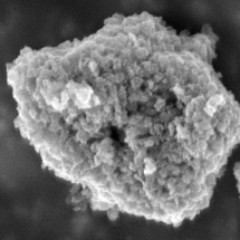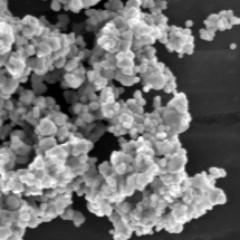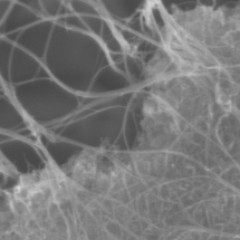- Artificial Intelligence (AI)
- Occupational exposure limit values
- Climate Change and Occupational Safety
- List of CMR substances
- Electromagnetic fields
- Ergonomics
- Industrial Security
- Collaborative robots
- Noise
- Nanoparticles at the workplace
- Optische Strahlung
- REACH
- Reference materials
- Proficiency testing
- Vibration
- Virtual reality
- Work 4.0
Ultrafine aerosols and nanoparticles at the workplace

Scanning electron microscopic images of particles
Fig.1: Titanium dioxide

Fig. 2: Silver

Fig. 3: Single walled nano tubes
Source: Finnish Institute of Occupational Health (FIOH), ultrafine aerosols and nanoparticles at the workplace
Together with biotechnology and information technology, nanotechnology is regarded as one of the driving forces behind a new industrial revolution which will impact upon the lives of all people in various ways. According to estimates, nanoscale products or products manufactured with the aid of nanotechnology will account for trade to a value of US$1 trillion by 2015. Compared to larger particles of the same material nanomaterials and nanoparticles by virtue of their new properties enable new products with either significantly better performance or completely new characteristics.
What are nanoparticles?
"Nanoparticles" is the colloquial term for objects with two or three dimensions of between 1 and 100 nm and manufactured specifically for their particular material properties.
What are ultrafine dusts?
Ultrafine dusts likewise exhibit particle sizes in the range from 1 to 100 nm. They are however produced unintentionally, for example during thermal processes (engine exhaust fumes, welding processes, domestic heating, candlelight) or the machining of materials. Particles with dimensions of 1 to 100 nm can also be found in aerosols in the natural environment. The precise definition of nanoparticles and ultrafine particles is contained in the following ISO technical specifications:
- ISO/TS 27687:2008 "Nanotechnologies – Terminology and definitions for nano-objects – Nanoparticle, nanofibre and nanoplate"
- ISO/TS 80004-1:2010 "Nanotechnologies – Vocabulary – Part 1: Core terms"
- ISO/TS 80004-3:2010 "Nanotechnologies – Vocabulary – Part 3: Carbon nano-objects".
Agglomerates and aggregates
Both nanoparticles and ultrafine particles may occur as either agglomerates or aggregates. In these cases, many much smaller particles are combined to varying degrees to form larger structures. The question of whether nanoparticles may be released from agglomerates or aggregates in the human body, and if so under what conditions, is the subject of intensive research.
The surface is responsible for the effect
The new, desired properties of nanoscale materials prompt the question of whether the existing methods for the toxicological testing of substances are also appropriate for nanoscale particles. Nanoparticles can be expected to penetrate barriers in the body and to enter organs inaccessible to larger particles.
Both the desired and undesired effects of nanoparticles are partly attributable, independent of their chemical nature, to their surface area and particle number, which are greater by orders of magnitude than those of coarser particles of the same composition. If we imagine dividing a cube with an edge length of 1 cm and a surface of 6 cm² into cubes with an edge length of 1 nm, the result is 1021 cubes with a total surface area of 6 000 m². The total mass and volume of the cubes remains unchanged, however.
European Commission recommendations for the definition of nanomaterials
Decisions in industrial practice do not concern whether a single particle is or is not a nanoparticle. Rather, larger product quantities, for example a sack of a powdered ingredient for a paint, is to be be assessed for the hazard they pose, in order to consider them as nanomaterials if necessary and to take suitable protective measures. The European Commission Recommendations of 18 October 2011 on the definition of nanomaterial [1] and the accompanying memorandum (MEMO/11/704) [2] represented the (provisional) conclusion of a discussion that had lasted for several years.
According to this memorandum, member states, Union agencies and economic operators are "invited to use" the following definition of the term "nanomaterial". The Commission emphasizes that this definition is based solely upon the dimensions of particles and does not constitute any indication of hazards or risks which may (or may not) be presented by a particular nanomaterial.
The key passages of the recommendations, Section 2, are as follows:
"'Nanomaterial' means a natural, incidental or manufactured material containing particles, in an unbound state or as an aggregate or as an agglomerate and where, for 50% or more of the particles in the number size distribution, one or more external dimensions is in the size range 1 nm-100 nm."
"In specific cases", a threshold below 50% of the number size distribution may be used. In addition, fullerenes, graphene flakes and single wall nanotubes with one or more external dimensions below 1 nm are to be regarded as nanomaterials. A material with a specific surface area to volume ratio of over 60 m²/cm³ is to be regarded as a nanomaterial.
This definition is to be reviewed by the end of 2018, particularly with regard to the threshold value of 50%, and also to whether "materials having internal structure or surface structure in the nanoscale such as complex nano-component nano-materials including nano-porous and nano-composite materials should be included."
The Commission does not wish this definition to prejudice the scope of statutory provisions: "It may in some cases be necessary to exclude certain materials from the scope of application of specific legislation or legislative provisions even if they fall within the definition." This could lead to one and the same material being considered a nanomaterial and subject to particular risk assessment in one legal area, and not in another. This possibility, which in the first instance is only theoretical, is all the more probable given the wide scope of the definition.
"Natural" materials could also mean materials which are quarried and processed in high tonnages.
"Incidental materials" could for example include welding fumes.
The threshold value of 50% of the number size distribution could lead to very many or all pigments and fillers falling within the definition of nanomaterials, and therefore many thousands of products already on the market being declared "nanoproducts" overnight [3]. The situation as a whole is also exacerbated by the fact that suitable measurement methods for determining the threshold value have yet to be developed or harmonized in order for "knowledge of typical concentrations of nanoparticles in representative sets of materials" to be developed in accordance with the intent of the Commission "guidance". For the drafting of statutory provisions, the question arises as to whether new findings justify the inclusion of legacy materials under the heading of "nanomaterials". Conversely, the exclusion of legacy materials by definition would prove to be difficult.
It should be noted that with the recommendation, the European Commission has selected the most powerful legal instrument after the regulation and the directive. Even though the recommendation is not binding upon the parties for which it is intended, it does not follow that it has no legal effect. It certainly has a binding effect upon policy, as can be seen from the example of the proposal for the biocide regulation [4] adopted by the European Parliament on 19 January 2012. This defines a nanomaterial as "a natural or active manufactured substance or non-active substance containing particles, in an unbound state or as an aggregate or as an agglomerate and where, for 50% or more of the particles in the number size distribution, one or more external dimensions is in the size range 1 nm-100 nm."
Further information

[1] Commission Recommmendation of 10 June 2022 on the definition of nanomaterial (PDF, 714 KB)
[2] www.farbeundlack.de/ layout/set/print/Blog/ Auf-die-wahren-Gefahren
Published: 29 November 2011 by Dr Dietmar Eichstädt, Verband der deutschen Lack- und Druckfarbenindustrie e.V. (in German)
General background:
Jahresbericht 2001 aus dem Messnetz des Umweltbundesamtes (in German)